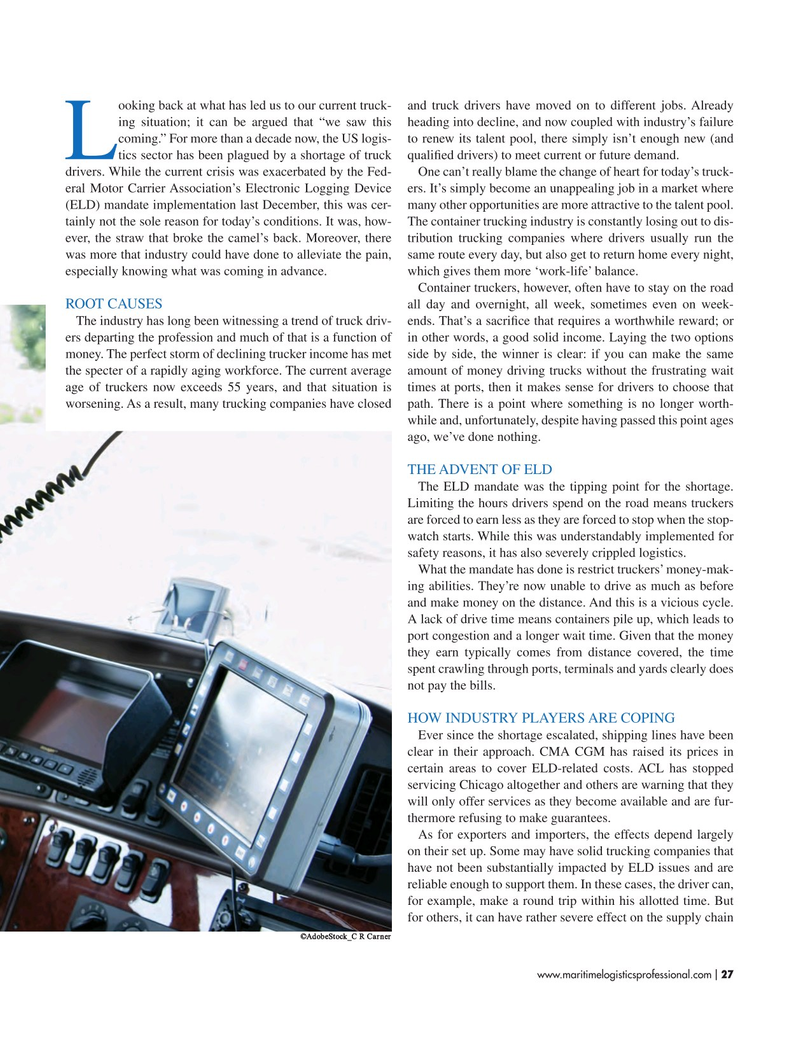
Page 27: of Maritime Logistics Professional Magazine (Mar/Apr 2018)
IT & Software
Read this page in Pdf, Flash or Html5 edition of Mar/Apr 2018 Maritime Logistics Professional Magazine
ooking back at what has led us to our current truck- and truck drivers have moved on to different jobs. Already ing situation; it can be argued that “we saw this heading into decline, and now coupled with industry’s failure coming.” For more than a decade now, the US logis- to renew its talent pool, there simply isn’t enough new (and
Ltics sector has been plagued by a shortage of truck qualifed drivers) to meet current or future demand.
drivers. While the current crisis was exacerbated by the Fed- One can’t really blame the change of heart for today’s truck- eral Motor Carrier Association’s Electronic Logging Device ers. It’s simply become an unappealing job in a market where (ELD) mandate implementation last December, this was cer- many other opportunities are more attractive to the talent pool. tainly not the sole reason for today’s conditions. It was, how- The container trucking industry is constantly losing out to dis- ever, the straw that broke the camel’s back. Moreover, there tribution trucking companies where drivers usually run the was more that industry could have done to alleviate the pain, same route every day, but also get to return home every night, especially knowing what was coming in advance. which gives them more ‘work-life’ balance.
Container truckers, however, often have to stay on the road
ROOT CAUSES all day and overnight, all week, sometimes even on week-
The industry has long been witnessing a trend of truck driv- ends. That’s a sacrifce that requires a worthwhile reward; or ers departing the profession and much of that is a function of in other words, a good solid income. Laying the two options money. The perfect storm of declining trucker income has met side by side, the winner is clear: if you can make the same the specter of a rapidly aging workforce. The current average amount of money driving trucks without the frustrating wait age of truckers now exceeds 55 years, and that situation is times at ports, then it makes sense for drivers to choose that worsening. As a result, many trucking companies have closed path. There is a point where something is no longer worth- while and, unfortunately, despite having passed this point ages ago, we’ve done nothing.
THE ADVENT OF ELD
The ELD mandate was the tipping point for the shortage.
Limiting the hours drivers spend on the road means truckers are forced to earn less as they are forced to stop when the stop- watch starts. While this was understandably implemented for safety reasons, it has also severely crippled logistics.
What the mandate has done is restrict truckers’ money-mak- ing abilities. They’re now unable to drive as much as before and make money on the distance. And this is a vicious cycle.
A lack of drive time means containers pile up, which leads to port congestion and a longer wait time. Given that the money they earn typically comes from distance covered, the time spent crawling through ports, terminals and yards clearly does not pay the bills.
HOW INDUSTRY PLAYERS ARE COPING
Ever since the shortage escalated, shipping lines have been clear in their approach. CMA CGM has raised its prices in certain areas to cover ELD-related costs. ACL has stopped servicing Chicago altogether and others are warning that they will only offer services as they become available and are fur- thermore refusing to make guarantees.
As for exporters and importers, the effects depend largely on their set up. Some may have solid trucking companies that have not been substantially impacted by ELD issues and are reliable enough to support them. In these cases, the driver can, for example, make a round trip within his allotted time. But for others, it can have rather severe effect on the supply chain ©AdobeStock_C R Carner www.maritimelogisticsprofessional.com 27
I

 26
26

 28
28
